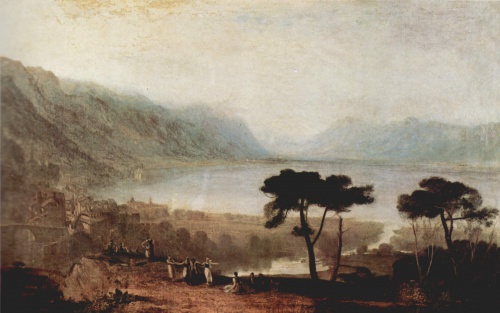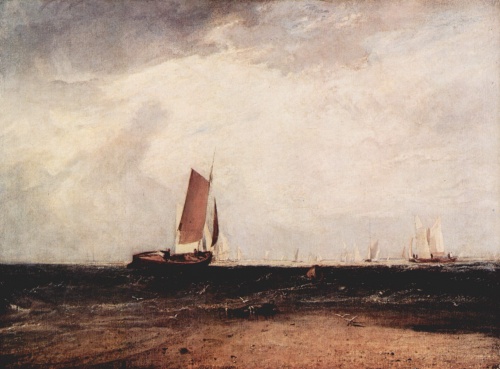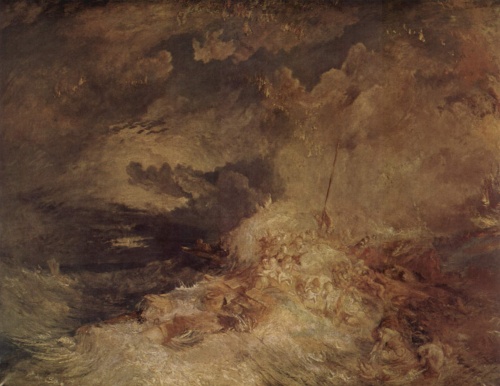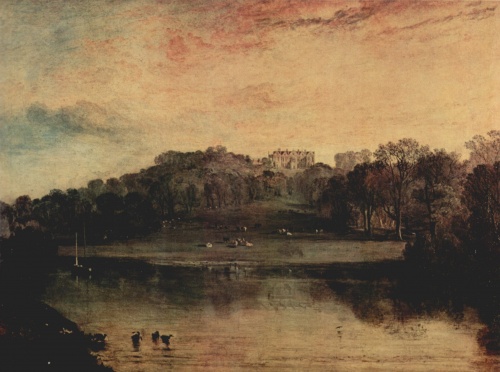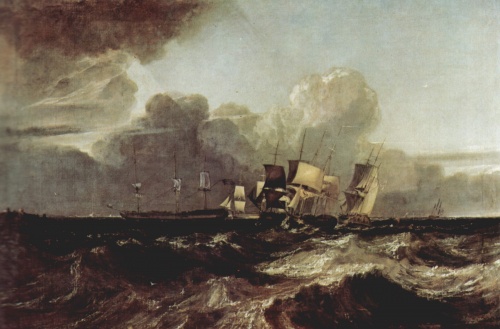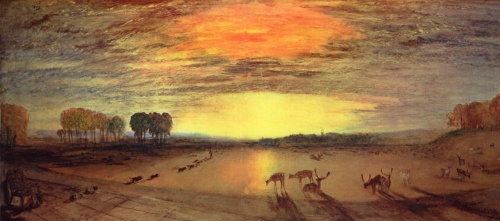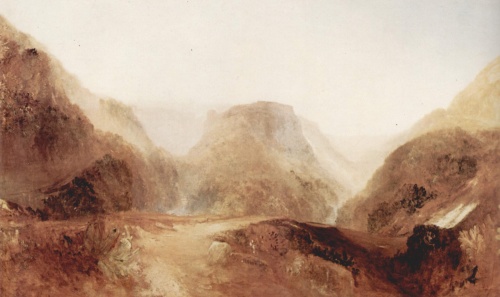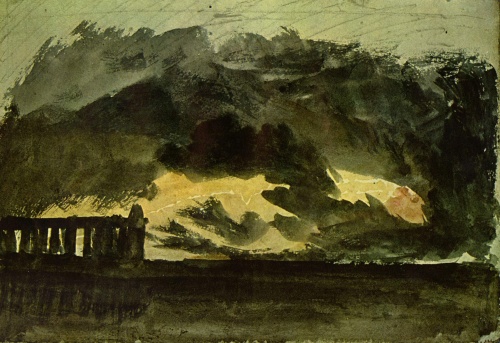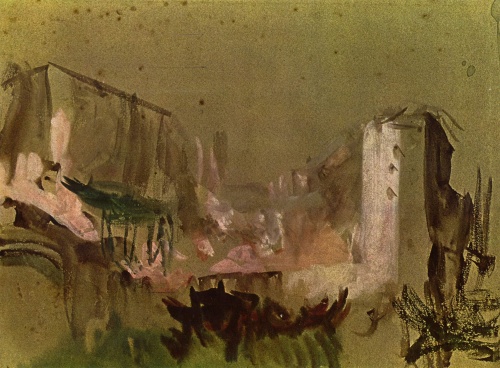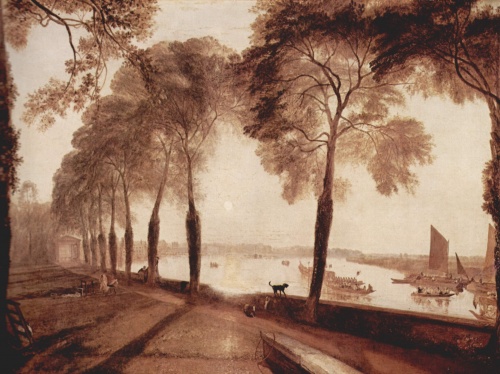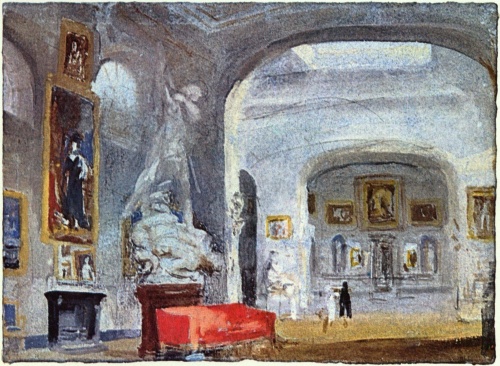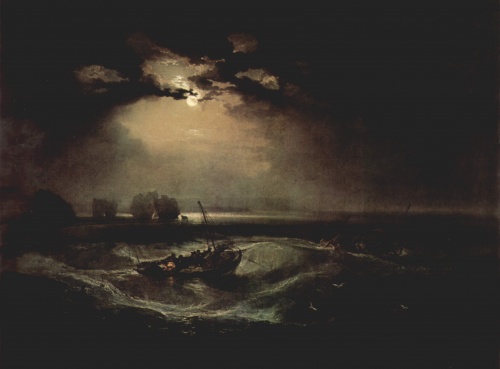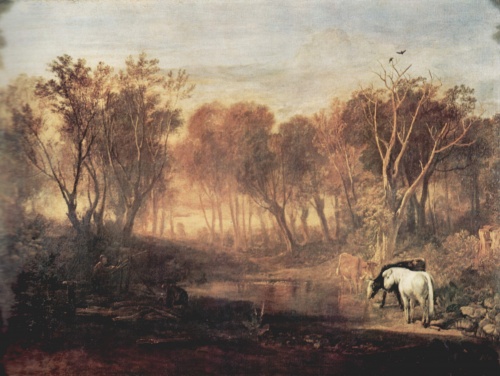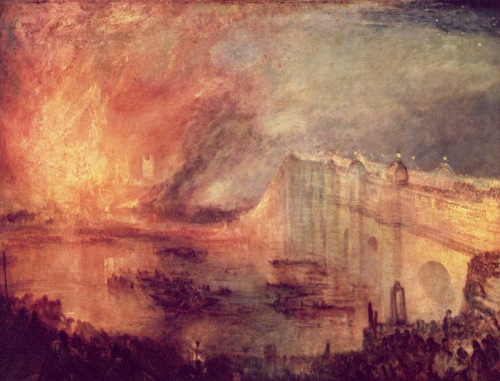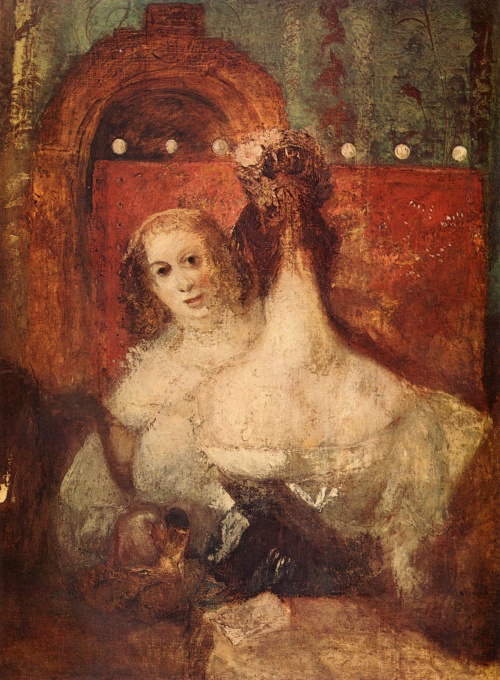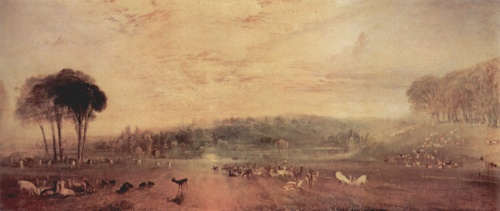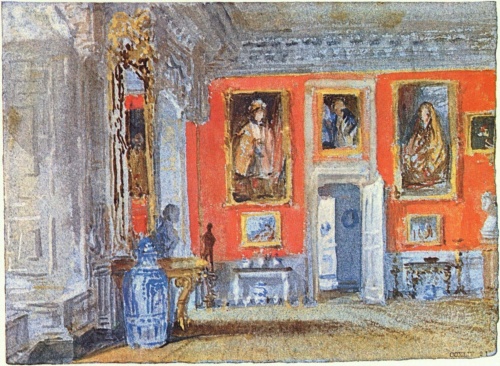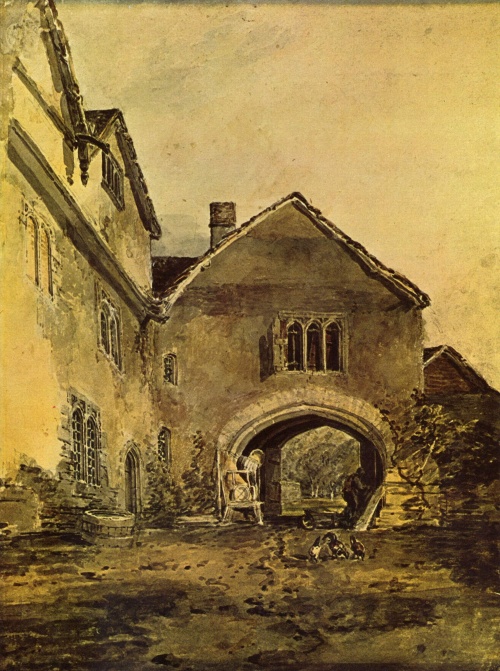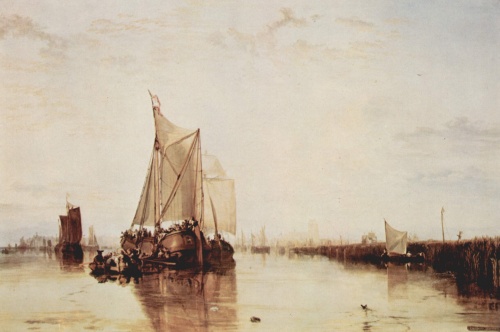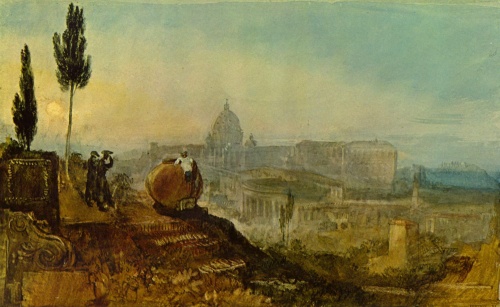William Turner (96 works)
Разрешение картинок от 2048x1229px до 2536x3442px
Among English artists, the amazing figure of one of the most brilliant representatives of world art, Joseph Mallord William Turner, rises like an extraordinary colossus. He was only 15 years old when his paintings appeared at the Royal Academy. English painting at the beginning of the 19th century saw several remarkable artists. Constable and Turner became the main representatives of the romanticism movement of that era. The Romantics sought to reflect in their works the unknown mystery of the surrounding world. The originality of English romanticism, which is characterized by a deep sense of nature, presented not in static conditions, but in movement, and often complemented by the presence of man, was most fully manifested in the genre of landscape. Turner was that landscape painter of a completely romantic type who was able to comprehend the artistic transmission of the forces of untamed nature. His landscapes, bold in color and light-air exploration, are distinguished by unusual effects and a colorful phantasmagoria of the forces of nature.
His versatile talent, the ability to make his own way, combined with a deep understanding of the traditions of the old masters, led him to worldwide success, almost impossible for a landscape artist in the 18th century.
Turner was born in the thick of the cramped alleys of London, on the banks of the Thames, on April 23, 1775. Here the boy felt the pulse of life in a huge trading city. His father owned a barber shop, among whose regular customers were many artists and engravers. Therefore, it was not surprising that Turner’s father hung his son’s watercolors in his shop when he was barely twelve years old, and began selling them for two or three shillings apiece. These were at first copies of the then fashionable topographical views of picturesque areas, castles, ruins, and architectural monuments of London. The father viewed his son's drawing lessons not as empty entertainment, but as a fairly reliable source of extra income. At the end of the 18th century, topographical sketches were very popular in England, then translated into engravings illustrating all sorts of guidebooks and descriptions. On the recommendation of some artists who noticed the boy’s talented drawings, in December 1789 he was enrolled as a free student at the Royal Academy. When Turner was only 15 years old, one of his drawings was accepted for exhibition at the academy.
Turner becomes close to Dr. Monroe's circle and to the best English watercolor masters, passionate about new ideas of "picturesque images of a grandiose, majestic landscape." Turner was also greatly influenced by Gilpin’s teaching on the harmony of colors, which advised “to reduce the entire picture to the main, or key, tone, which in a landscape should always be taken from a cloudless area of the sky.” In Monroe's house, artists mostly copied the works of the old masters, and Turner, when he wanted to understand the achievements of an artist, instead of copying, painted an original picture in the appropriate style.
Turner gradually moved from watercolors to oil painting. Turner was determined to achieve recognition and throughout his life he tried to prove that a landscape can express the highest concepts and feelings no worse than a historical painting. The first painting he showed at an academic exhibition in 1796 was Fishermen at Sea, or Marina Chomley. It depicts several fishing boats on the open sea at night. Moonlight pouring through the breaks in the clouds illuminates a boat on the waves, on which the reddish light of a lantern is blinking. Turner masters the possibilities of oil painting that are unusual for him: he enhances the contrasts between illuminated and darkened parts and tries to convey the subtle difference in the reflexes of a lantern from the glare of moonlight on the wavering water surface of the ocean. Already in this first oil painting, he builds a restless oval of light in the composition and surrounds the month with a foggy halo. Turner embodied in this picture his tragic feeling of the instability of existence in the instability of the oncoming foamy waves, the collision of sharp diagonals of masts and sails and the hopelessness of the efforts of people swarming in boats, snatched from the darkness of an approaching storm by a randomly breaking ray. The characteristic oval of the composition is especially clearly visible in the preparatory drawing with its black bulk of a ship thrown on its side and a huge curved wave of a fragile boat rushing across it in the orbit, the white sail of which is rapidly rushing towards its destruction and seems to be crying out for help.
Turner took a further step forward in Lake Buttermere, with Rainbow and Shower, shown two years later. Turner tries to express in his paintings a sublime romantic feeling of merging with nature. Perhaps this is why there is an increased contrast of thunderclouds, gloomy mountains on the sides and the shining distance of the valley in the center, where one end of a rainbow shimmering with all colors descends. By the way, a rainbow is reflected in water, which in reality cannot be, since it does not occupy a specific place in space. But Turner was never embarrassed by inconsistencies if he needed them in the picture. The artist is very passionate here
giving aerial perspective and searching for gentle gradations of light transitions.
Turner had a habit of accompanying the titles of his paintings in exhibition catalogs with quotations from his favorite poets, Thomson, Milton, or his own poems. Moreover, these quotes almost always related to either light or some atmospheric phenomena.
The sea, fog and sun were the artist’s favorite themes. In the painting “The Sun Rising in the Fog. Fishermen Selling Fish” (1807), these three motifs are combined into a harmonious whole.
There is a special emotional sincerity in the artist’s early works; they are, as it were, lyrical fragments of a person’s free self-expression. Although the basis of all Turner’s compositions - even the later ones, even those that are reduced to vague light phantasmagoria, is a completely strictly worked out linear drawing, clearly indicating not only spatial plans, but also each three-dimensional object.
Turner dreamed of creating a kind of encyclopedia of the landscape, showing all the diversity of its possibilities and breadth of range. He wanted to prove that a landscape can evoke a variety of experiences and feelings, give rise to a variety of ideas and images. Turner boldly undertakes the enormous task of creating one hundred compositions, covering all varieties of landscape - "historical, pastoral, architectural, sea and mountain." The publication plan was almost completed, more than a dozen compositions and engravings had already been prepared, when Turner abandoned this whole plan.
Brought up on the aesthetic theories of the Enlightenment, Turner considered it his duty to respond to the academy’s invitation to teach a course in perspective within its walls. “The main thing to strive for in art is a true comprehension of the beautiful in nature,” he said in a sketch for his first introductory lecture. Turner studied nature so carefully, was so devoted to his creatures and was gifted with such a rich imagination that once, in 1806, while composing the magical painting “The Garden of the Hesperides,” he painted his fantastic guardian dragon in the very form that appeared in one antediluvian animal , subsequently excavated (Iguanodon). In his lectures, Turner tried to include everything from Euclid and Pliny to the latest scientific hypotheses, discoveries and theories of chemists and opticians of the early 19th century, but did not ignore the difference between the laws discovered by science, in particular optics, and the rules suitable for painters. In his lectures he discussed questions of light, shadow and the problem of reflexes in water, glass and metals; the question of the relationship between elementary geometric forms and shape-building in the fine arts; about the nature of vision and the structure of the eye; on the classification of the three primary colors - red, yellow and blue - according to their tonal relationships and physiological effects; in general about color, which he considered the decisive element of painting. Turner was also interested in chemistry; he knew the chemist Field, who produced paints for artists. And Turner was always interested in the practical application of new principles and discoveries of science to the painting process itself. Turner was also familiar with the most outstanding physicists of his time - Faraday and Brewster. He intuitively sensed the coming scientific discoveries: as Kenneth Clarke said, “it is the instinctive understanding of the structure of the physical world of our planet, created by the pulsation and endless interpenetration of waves, that makes Turner so universal and connects him with the most outstanding physicists of our time.”
All this was a real innovation in painting at that time. Turner dared to go against generally accepted artistic traditions. After all, then everyone firmly adhered to the idea that every picture must be painted in muted dark brownish colors - to match the darkened varnish on the canvases of the old masters. Art lovers carried a yellow filter called "Claude Lorrain glass" and inserted it into their eyes instead of a monocle when looking at paintings, so that they could see them painted in the golden tones of antiquity. Even Turner's very restrained attempts to convey bright, daylight and lighten his palette gave rise to the derogatory nickname of the White Artist. White color was considered “not picturesque” and should be avoided in every possible way. He seemed "too active", "not amenable to discipline and harmony", "always out of tune."
At this turning point, Turner first came to Italy, where he felt first of all the heat, brilliance and radiance of the sun and the enlightenment, permeated with the light of Italian nature. He spent only about five months in Italy. Turner worked incredibly hard, and he returns to classic stories. Its colors became so bright that Constable was even frightened: “Turner has gone crazy with his skill, the picture is painted in saffron and indigo!” And it seemed to Turner himself that he still had not achieved in his paints that brilliance and dazzling radiance, that intensity of color of southern nature that was forever imprinted in his phenomenal visual memory. He continued this color symphony freed from convention in
hear it internally and look for ways to express it. Turner gravitated towards the Venetian school, especially Titian, Veronese and Tintoretto.
After his second trip to Italy in 1829, Turner showed the best of his historical paintings, “Ulysses Mocks Polyphemus,” the most traditional in plot and innovative in its interpretation of the work. Polyphemus is a terrible giant cyclops, the son of Poseidon, living alone in a cave and herding sheep. During his journey, Odysseus arrives on the island and blinds Polyphemus with cunning. The film contains a peculiar combination of ancient mythology with the latest scientific data and specific observations. One of Turner's researchers calls this painting a "mythology of color."
The painting depicts the ship of Ulysses sailing away from the deceived and blinded Polyphemus. Turner painted smoke rising from the mountain of the Cyclops, and the huge figure of Polyphemus himself, merging with the mountain and smoke, is depicted as “a monstrous growth on a lonely mountain.” But the smoke painted by Turner rises not from shepherds' fires, as loosely translated, but from the crater of a volcano. Turner not only sketched the eruption of Vesuvius, but also framed his open sketchbook so that “the volcano would sign it” with hot ash. The island of Polyphemus is volcanic, and it itself, as its organic part, is directly connected with ideas about the elemental forces of nature - after all, according to Hesiod’s Theogony, the brothers Polyphemus, Steropes and Arges were personifications of thunder and lightning. At the end of the 18th century, a scientific hypothesis was put forward according to which volcanic ash and lightning during electrical discharges form meteorites. Thunder booms when meteorites fall. And the sea caves on the left in the picture, in the depths of which flames are blazing, judging by their size, are not the dwelling of the Cyclops at all, but, perhaps, are personifications of another theory - Erasmus Darwin, who believes that the origin of volcanoes is associated with the infusion of sea water into the flaming bowels of the earth . The Odyssey says nothing about a flock of shining Nereids frolicking around Ulysses' galley. Turner used for his lectures the then popular manual “The Art of Painting” by Leresse, according to which the Nereids should represent “the various qualities and effects of water.” In this picture, the Nereids with stars on their foreheads apparently embody, according to Turner, the phenomena of phosphorescence in nature. And the famous revolutionary and scientist Joseph Priestley gave a summary of information about the glow of some objects in connection with decay and other phenomena of phosphorescence in his study “The History and Present State of Discoveries in the Field of Vision, Light and Color” (1772). Turner also used this book in preparation for his lectures, as well as the poem “Botanical Garden” by Erasmus Darwin. The latter describes observations of travelers in tropical seas, “when a ship sails, as if surrounded by lights, and leaves behind a luminous trail. And if the sea is slightly agitated, every drop glows and flickers. Another unique feature of Ulysses is a very special interpretation of the pre-dawn sky. At first glance, the heavens, where the wonderful extravaganza of the sunrise plays out, are given within the limits of very precise observation. But a careful look will notice that from the place of the appearance of the luminary, an image of rearing horses, “outlined by a fiery contour, ascending into the heavens with fluttering manes, unfolds like a fan, surrounded by flashes of purple clouds." These Aurora horses were taken by Turner directly from the sculptures of the Parthenon pediment. At home on Queen Anne Street, he kept plaster casts from the Parthenon sculptures. Thus, Turner identified his allegorical Aurora horses with their prototypes in plastic. Turner, on the other hand, tried to combine the ideal and the real, to merge the mythological image with the image of the real landscape. And in his other paintings, the figurative structure is usually associated with collisions and transformations of the elements, especially light and darkness. Turner's "Ulysses" is one of the steps leading to the fusion of history, reality and imagination in the artistic images of his later works.
“Ulysses” was called a melodrama, an operatic setting; they noticed that Ulysses’ galley is flooded with sun even in those parts where its rays cannot penetrate; the contrast between the darkness of the Cyclops’ cave and the brilliance of the morning sky is too great. But Turner was never embarrassed by the inaccuracies of a naturalistic order; he boldly increased the size of castles or bell towers, moved them to where he considered it necessary if the structure of the picture required it, or increased the sonority of color if, in his opinion, the expressiveness of the whole benefited. Turner was skeptical about the possibility of establishing “immutable,” rigid laws of color and light for painting.
One of Turner's most interesting works is the large oil painting "Juliet with her Nanny", shown at an art exhibition in London in 1836. He allowed himself to transfer the action of Shakespeare's tragedy from Verona to Venice and depicted Juliet and her nanny admiring from the flat roof of the palace the carnival fun below in St. Brand. The point of view is taken very highly. Here Te
The artist strives not for romantic effects, but for a picturesque depiction of some landscape motif that captivated him. His paintings prepared several generations of English readers for the perception of works of art, including illustrations for the poems of Rogers and Walter Scott.
Among the paints preserved in the artist's studio, there are twelve varieties of yellow. Four of them were new pigments discovered in the 19th century. The emphasis on yellows can be explained not only by a purely technical interest in new pigments, but was caused by his growing need for pure, unmixed light colors. It should be noted that in Goethe's teaching on colors, yellow is placed above all others as the first derivative of light. Goethe associates him with a “calm, cheerful, gently exciting character.” And Turner himself joked: “They say I took all the yellow paint for myself...” For a long time, the most important thing in painting, in addition to the plot, seemed to be the transfer of tangibility, the volume of what was depicted, which could be achieved with plasticity or a clear outline. And by the end of his life, Turner translated everything into pure color: the visible world, light, mood. But this color was never arbitrary; it is full of deep meaning.
It is enough to look closely at the compositional scheme of Turner’s paintings of the late period, and it turns out that the perception of depth in them changes all the time: simultaneously the impression of a flat surface and the illusion of going deeper appear. The last impression is caused mainly by triangles of shadows, creating something like a tunnel going into the depths. One can distinguish three stages of the perception of space in Turner's paintings: in the first, only a luminous colorful surface appears; in the second, this surface begins to acquire volume, depth, space filled with air, the play of light on individual objects; finally, even individual gestures and details stand out, meaningful despite their stinginess and laconicism. Turner has always admired the fury of the elements, where everything is subject to the vortex cycle of a hurricane, where grains of sand rushing with great speed form the walls of a rotating empty funnel around the sun. After all, the struggle between light and darkness is Turner's main theme.
He is constantly looking for unusual subjects; the most perfect and unexpected image of a storm at sea is given by Turner in the 1842 painting “Blizzard. A steamer leaves the harbor and gives a distress signal, having found itself in shallow water.” In the catalogue, in a note to the title, it is added: “The author was on the Ariel on that stormy night.” Turner seemed to put a tragic worldview into this work - a premonition of catastrophes threatening the world. It seemed to him that the pictures of raging elements: avalanches, storms, blizzards and hurricane - in general, all kinds of emergency states of nature can adequately convey the confusion of the human heart and mind, cleanse the soul and consciousness.
Huge ocean swells, thick fog and whirlwinds of wet snow merge into a single frantic whirlpool. Its center is the vague outline of the ship. But there is more to it than just the surface description of the storm. This is the embodiment of not only observations of raging nature or just visual impressions, but the creation of some kind of indecomposable unity - a riot of elements, colors and internal experiences. Criticism, of course, did not fail to call the painting “soap suds mixed with whitewash solution.” Turner became angry: “I didn’t write it to be understood, I just wanted to show what it was like. I begged the sailors to tie me to the mast so that I could watch; I was tied for four hours, I had no hope of surviving, but "I considered it my duty to give an account of this if I survived. And the picture does not have to please anyone." When an Oxford student tried to console the old man, he shouted: “Have they ever seen the sea?!”
It does not have landscapes from a close point of view. Turner's stage almost always spans several dozen miles, it represents vast spaces, and above this endless perspective reigns the majestic circle of the sun...
Thus, Turner moved further and further away from detailed descriptiveness. To express his idea, he would be just as embarrassed and unnecessary to count all the details of objects as a philosopher, formulating his idea.
Turner spent a lot of time studying the various states of atmosphere and lighting, and especially the sky as the main key in the landscape. Turner said that to study clouds, “he would take a boat, lie on its bottom on his back, anchor in the river, look at the sky for hours, and sometimes for days, until he caught some light effect that he would like to transfer to canvas".
Turner is captivated by the fluidity of clouds, their continuous change and movement, as if realized before the viewer’s eyes. The purpose of such experiments is to capture the continuously changing color and light symphony of the sky.
Turner was the first in European painting to depict atmospheric effects. Fog, air haze at sunset, clouds of locomotive steam or just a cloud became full-fledged motives for him. Turner created a series of watercolors "Rivers of France", which included very carefully
This watercolor "Rouen Cathedral", made on the basis of sketches dating back to 1821. She was frequently exhibited in the 19th century and may have been the inspiration for Claude Monet's series of Rouen Cathedral paintings (1892-1894). Monet visited London more than once; in particular, he was in 1892 and studied Turner’s things. In some watercolors, Turner anticipates Monet, trying to capture the same place at different times of day.
“The frigate “Bold”, towed to its last mooring for scrapping” (1838) is a work of the late period. The artist himself saw the ill-fated ship being pulled into Margate when he accompanied the funeral procession of his deceased friend Lord Egremont to Petworth. This meeting shocked him: everything goes away and everything changes. After all, he painted “The Brave One” - an active participant in the famous Battle of Trafalgar - in his early painting of 1808. But now “Brave” is no longer needed. A small, nondescript black tugboat, puffing busily and blowing a red tail of smoke, pulls a huge, shining white, stately combat frigate to its last stop, marked by a dark buoy. Behind the Brave, several more white ghosts of sailing ships are visible, which are threatened with the same fate. The left cool bluish side of the canvas with the new moon reflected in calm greenish streams, and the orange-red sunset on the right with the white disk of the setting sun; all these contrasts of light and advancing darkness, cold and hot tones, old and new are not only an elegy for the passing world, but also a kind of acceptance of the inevitability of destruction and renewal.
Turner, as we see, is one of the few artists who accepted these inevitable changes. Over his long life, he saw his native London transform from the large village of his childhood into one of the world's largest industrial centers. And it was Turner who first expressed this in his works. The complexity of the color scheme of "Brave" with its roll call of cold bluish-lilac and warm orange-scarlet colors reflects the complexity, but by no means the dullness of the emotional structure of the picture. Critics attacked Turner for his “extravagance,” the unthinkability of combining the moon and the sun on one canvas, and so on. Only the most insightful, like W. M. Thackeray, appreciated this, as he called it, “national ode.”
However, by the end of the 1830s, Turner completely went out of fashion. He never enjoyed success in court circles. The freedom and breadth of his writing were strikingly different from the increasingly petty and polished paintings of the vast majority of successful Victorian artists of the mid-century. But over the many years that he exhibited, viewers became accustomed to his “eccentricities.” In the first quarter of a century, he managed to win over a new, much wider audience: middle-income intellectuals who understand painting, but cannot afford to buy expensive paintings. Turner stopped reacting to criticism. He no longer wanted to sell his most significant works - he made them for himself and future generations.
... He died reaching out to the window to look once more at the Thames and the sun. The doctor who was present at his death recorded that “just before nine o’clock the sun came out and its beam fell directly on him - as bright as he liked to watch.”
Joseph Mallord Turner's contemporaries called him a painter of "golden visions, magnificent and beautiful, although without substance." He decided to depict the sun, sunlight and sunlight with such truth that had never happened before in painting. And he began to strive to convey the sun in all its radiance. He searched for a long time, but he achieved his goal and expressed on canvas what no one had actually depicted before. He intricately combined virtuoso technique and tongue-tiedness, isolation and the desire to serve people, practical intelligence and philanthropy, reverence for the pictorial traditions of the past and a tireless search for his own language. Everything created by Turner, the greatest English artist, was so diverse and reflected such bold searches and discoveries that we can safely say that he created for future generations. The artist went through a difficult path of complex quests and rose to a deep understanding of reality as the unity of color and light in their elusive movement, devoid of material, tangible form.


